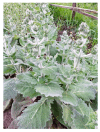Phytochemical Profile, Antioxidant Capacity and Anticancer Potential of Water Extracts from In Vitro Cultivated Salvia aethiopis
- PMID: 40286005
- PMCID: PMC11990555
- DOI: 10.3390/molecules30071427
Phytochemical Profile, Antioxidant Capacity and Anticancer Potential of Water Extracts from In Vitro Cultivated Salvia aethiopis
Abstract
Salvia aethiopis L. (Mediterranean sage) is a medicinal plant known for its rich phenolic content and different therapeutic properties. This study evaluated the phytochemical composition, antioxidant capacity and anticancer potential of water extracts from in vitro cultivated S. aethiopis. The extract exhibited a high total polyphenol (110.03 ± 0.7 mg GAE/g) and flavonoid (7.88 ± 0.25 mg QE/g) content, along with a strong oxygen radical absorbance capacity (an ORAC value of 3677.9 ± 24.8 µmol TE/g). LC-HRMS analysis identified 21 bioactive compounds, including salvianic acid C, rosmarinic acid, salvianolic acid K and various organic acids. A cytotoxicity evaluation using the Neutral Red Uptake assay showed that the extract had a low toxicity to non-cancerous BALB/3T3 cells. An antiproliferative activity assessment via the MTT assay revealed selective cytotoxicity against Hep G2 hepatocellular carcinoma cells (IC50 = 353.8 ± 21.8 µg/mL) and lung (A549) and prostate (PC-3) carcinoma cell lines. Migration assays and cytopathological evaluations confirmed the significant inhibition of cancer cell proliferation, the suppression of migration and G2/M cell cycle arrest. Flow cytometry revealed considerable increases in apoptotic and necrotic cell populations following treatment with S. aethiopis extract. These findings showed the potential of S. aethiopis as a promising source of bioactive compounds with antioxidant and anticancer properties, supporting its further exploration for therapeutic applications.
Keywords: LC-HRMS; Salvia aethiopis; antioxidant activity; apoptosis; cytotoxicity; hepatocellular carcinoma; phytochemicals.
Conflict of interest statement
The authors declare no conflicts of interest.
Figures







Similar articles
-
Comparison of the Phytochemical Properties, Antioxidant Activity and Cytotoxic Effect on HepG2 Cells in Mongolian and Taiwanese Rhubarb Species.Molecules. 2021 Feb 25;26(5):1217. doi: 10.3390/molecules26051217. Molecules. 2021. PMID: 33668690 Free PMC article.
-
Verbascum gimgimense an Endemic Turkish Plant: Evaluation of In Vitro Anticancer, Antioxidant, Enzyme Inhibitory Activities, and Phytochemical Profile.Cell Biochem Funct. 2024 Dec;42(8):e70023. doi: 10.1002/cbf.70023. Cell Biochem Funct. 2024. PMID: 39632482
-
Assessment of Phytochemical Profile, Antioxidant, and Anticancer Activity Against Colon Cancer-HT-29: A Potent Therapeutic Medicinal Plant (Tarenna alpestris) in Megamalai Hills, Western Ghats, India.Appl Biochem Biotechnol. 2025 May;197(5):3382-3406. doi: 10.1007/s12010-025-05193-5. Epub 2025 Feb 13. Appl Biochem Biotechnol. 2025. PMID: 39946058
-
A Review of Botany, Phytochemistry, and Biological Activities of Eight Salvia Species Widespread in Kazakhstan.Molecules. 2025 Mar 3;30(5):1142. doi: 10.3390/molecules30051142. Molecules. 2025. PMID: 40076365 Free PMC article. Review.
-
Utilizing Plant Phytoconstituents in Metal Oxide Nanoparticle Synthesis for Cancer Therapies.Curr Pharm Des. 2025;31(16):1270-1289. doi: 10.2174/0113816128329342241120105041. Curr Pharm Des. 2025. PMID: 39781736 Review.
References
-
- Shen N., Wang T., Gan Q., Liu S., Wang L., Jin B. Plant flavonoids: Classification, distribution, biosynthesis, and antioxidant activity. Food Chem. 2022;383:132531. - PubMed
-
- Poyraz İ.E., Çiftçi G.A., Öztürk N. Phenolic contents, in vitro antioxidant and cytotoxicity activities of Salvia aethiopis L. and S. ceratophylla L. (Lamiaceae) Rec. Nat. Prod. 2017;11:345–355.
MeSH terms
Substances
Grants and funding
LinkOut - more resources
Full Text Sources
Medical

